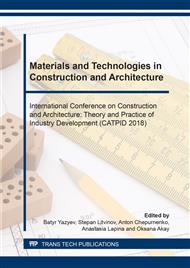[1]
V.P. Agapov, A.V. Vasiliev, Modeling of rectangular cross-section columns by volume elements using superelement technology, Structural Mechanics of engineering structures and buildings. 4 (2012) 48-54.
Google Scholar
[2]
A .L. Balushkin, Features of modeling the process of crack formation of reinforced concrete structures in a stage close to destruction, Bulletin of Civil Engineers. 3 (2010) 49-54.
Google Scholar
[3]
A.D. Beglov, R.S. Sanzharovsky, The theory of reinforced concrete structures calculation for strength and stability, Modern standards and European standards, Saint-Petersburg, (2008).
Google Scholar
[4]
A.V. Benin, Finite-element method for estimating the degree of corrosion of reinforcement by analysis of defects on the surface of a reinforced concrete element, Survey of Applied and Industrial Mathematics. 15 (2008) 112-114.
Google Scholar
[5]
A.M. Blyagoz, O.V. Shilyaeva, R.A. Khunagov, Simulation of the resistance of a reinforced concrete panel, New technologies. 3 (2012) 114-119.
Google Scholar
[6]
S.F. Klovanich, D.I. Bezushko, Finite element method in nonlinear calculations of spatial reinforced concrete structures, Odessa, ONMU, (2009).
Google Scholar
[7]
E.A. Korol, Y.A. Kharkin, Investigation of the stress-strain state of three-layer reinforced concrete elements and monolithic section constructions by computer simulation, Herald MSUCE. 4 (2010) 117-120.
Google Scholar
[8]
V.A. Muradyan, D.R. Mailyan, Reinforced concrete pillar with recessed longitudinal bars without transverse reinforcement, in: Calculation and design of reinforced concrete structures: a collection of scientific works, Rostov-on-Don, (2009).
DOI: 10.1051/matecconf/201710602008
Google Scholar
[9]
V.A. Muradyan, D.R. Mailyan, Method for calculating reinforced concrete eccentrically compressed columns, Engineering Bulletin of Don. 4 (2012).
Google Scholar
[10]
V.A. Muradyan, D.R. Mailyan, Stability of reinforcement rods in compressed reinforced concrete column, in: Construction - 2010: materials of the Scientific and Practical Conference, Rostov-on-Don, (2010).
Google Scholar
[11]
V.A. Muradyan, O.V. Shilyaeva, A.M. Blyagoz, To the calculation of reinforced concrete columns by the finite element method, New Technologies. 3 (2013).
Google Scholar
[12]
A.D. Nazarov, Investigation of the strength and fracture toughness of prestressed piles without transverse reinforcement, PhD Thesis, (2004).
Google Scholar
[13]
Russian Standard SP 52-101-(2003).
Google Scholar
[14]
Russian Standard SP 52-102-(2004).
Google Scholar
[15]
Information on http://gostrf.com/normadata/1/4293847/4293847507.pdf.
Google Scholar


